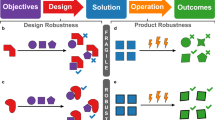Abstract
This paper studies the relationship between product quality as defined by tolerances on the product to tolerances on the parts. All the standard sure-fit and the statistical-fit tolerancing models, which seek to find the least cost tolerances for the parts given the product specification, are found to be convex. Thus conjugate duality provides a unifying framework for studying the relationship between quality and tolerancing and the analysis and solution of such problems. Moreover this convexity is maintained even with the addition of quality loss functions. Quality loss is modeled on the basis of parts or the product. The analysis leads to an analytic solution to a number of models including the quality loss model.
Similar content being viewed by others
References
G. Bennett and L.C. Gupta, Least cost tolerances-I, International Journal of Production Research 8(1) (1970) 65–74.
K.W. Chase and W.H. Greenwood, Design issues in mechanical tolerance analysis, Manufacturing Review 1(1) (1988) 50–59.
B.-W. Cheng and S. Maghsoodloo, Optimization of mechanical assembly tolerances by incorporation Taguchi's quality loss function, Journal of Manufacturing Systems 14(4) (1995) 264–276.
R.J. Duffin, E.L. Peterson and C. Zener, Geometric Programming-Theory and Application (Wiley, New York, 1967).
D.H. Evans, Statistical tolerance: The state of the art-Part I: Background, Journal of Quality Technology 6(4) (1974) 188–195.
W. Fenchel, Convex cones, sets and functions, Mimeographed lecture notes, Princeton University (1951).
R. Fourer, D.M. Gay and B.W. Kernighan, AMPL A Modeling Language for Mathematical Programming (Boyd and Fraser, Danvers, MA, 1993).
M.J. Hillier, A systematic approach to the cost optimization of tolerances in complex assemblies, Bulletin of Mechanical Engineering 5 (1966) 157–161.
J.-B. Hiriart-Urruty and C. Lemarechal, Convex Analysis and Minimization Algorithms (Springer, Berlin, 1993).
W.J. Lee and T.C. Woo, Tolerancing: Its distribution, analysis, and synthesis, Technical Report No. 86-30, Department of Industrial and Operations Engineering, University of Michigan, Ann Arbor, MI (December 1986).
W.-J. Lee and T.C.Woo, Tolerances: Their analysis and synthesis, Journal of Engineering for Industry 112(2) (1990) 113–121.
W. Michael and J.N. Siddall, The optimization problem with optimal tolerance assignment and full acceptance, Journal of Mechanical Design 103(4) (1981) 842–848.
B.A. Murtagh and M.A. Saunders, MINOS 5.1 User's Guide, Report SOL 83-20R, Department of Operations Research, Stanford University, Stanford, CA (1987).
D.B. Parkinson, Assessment and optimization of dimensional tolerances, Computer-Aided Design 17 (4) (1985) 191–199.
J. Peters, Tolerancing the components of an assembly for minimum cost, Journal of Engineering for Industry 92(2) (1970) 677–682.
E.L. Peterson, Geometric programming, SIAM Review 18 (1976) 1–52.
J.F. Pinel and K.A. Roberts, Tolerance assignment in linear networks using nonlinear programming, IEEE Transactions on Circuit Theory 19(5) (1972) 475–479.
R.T. Rockafellar, Convex Analysis (Princeton University Press, Princeton, NJ, 1970).
F.H. Speckhart, Calculation of tolerance based on a minimum cost approach, Journal of Engineering for Industry 94(2) (1972) 447–453.
M.F. Spotts, Allocation of tolerance to minimize cost of assembly, Journal of Engineering for Industry 95(3) (1973) 762–764.
G.H. Sunderland and B. Roth, Mechanism design: Accounting for manufacturing tolerances and costs in function generating problems, Journal of Engineering for Industry 97(1) (1975) 283–286.
G. Taguchi and Y. Woo, Introduction to Off-Line Quality Control (Central Japan Quality Control Association, 1985).
D. Wilde and E. Prentice, Minimum exponential cost allocation of sure-fit tolerances, Journal of Engineering for Industry 97(4) (1975) 1395–1398.
G. Zhang, Simultaneous tolerancing for design and manufacturing, International Journal of Production Research 34(12) (1996) 3361–3382.
Author information
Authors and Affiliations
Rights and permissions
About this article
Cite this article
Jefferson, T., Scott, C. Quality Tolerancing and Conjugate Duality. Annals of Operations Research 105, 185–200 (2001). https://doi.org/10.1023/A:1013309716875
Issue Date:
DOI: https://doi.org/10.1023/A:1013309716875




